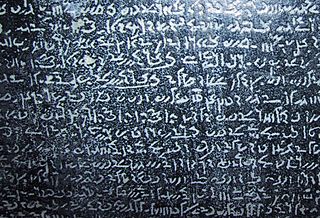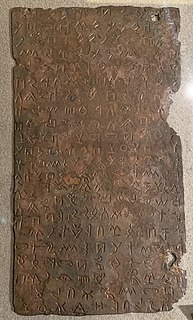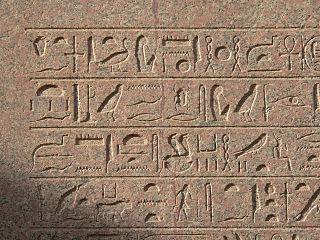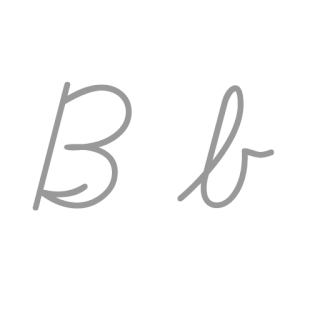
Egyptian hieroglyphs were the formal writing system used in Ancient Egypt. Hieroglyphs combined logographic, syllabic and alphabetic elements, with a total of some 1,000 distinct characters. Cursive hieroglyphs were used for religious literature on papyrus and wood. The later hieratic and demotic Egyptian scripts were derived from hieroglyphic writing, as was the Proto-Sinaitic script that later evolved into the Phoenician alphabet. Through the Phoenician alphabet's major child systems, the Egyptian hieroglyphic script is ancestral to the majority of scripts in modern use, most prominently the Latin and Cyrillic scripts and the Arabic script and possibly Brahmic family of scripts.
In the field of Egyptology, transliteration of Ancient Egyptian is the process of converting texts written in the Egyptian language to alphabetic symbols representing uniliteral hieroglyphs or their hieratic and Demotic counterparts. This process facilitates the publication of texts where the inclusion of photographs or drawings of an actual Egyptian document is impractical.

Demotic is the ancient Egyptian script derived from northern forms of hieratic used in the Nile Delta, and the stage of the Egyptian language written in this script, following Late Egyptian and preceding Coptic. The term was first used by the Greek historian Herodotus to distinguish it from hieratic and hieroglyphic scripts. By convention, the word "Demotic" is capitalized in order to distinguish it from demotic Greek.

The Byblos script, also known as the Byblos syllabary, Pseudo-hieroglyphic script, Proto-Byblian, Proto-Byblic, or Byblic, is an undeciphered writing system, known from ten inscriptions found in Byblos, a coastal city in Lebanon. The inscriptions are engraved on bronze plates and spatulas, and carved in stone. They were excavated by Maurice Dunand, from 1928 to 1932, and published in 1945 in his monograph Byblia Grammata. The inscriptions are conventionally dated to the second millennium BC, probably between the 18th and 15th centuries BC.

The writing systems used in ancient Egypt were deciphered in the early nineteenth century through the work of several European scholars, especially Jean-François Champollion and Thomas Young. Ancient Egyptian forms of writing, which included the hieroglyphic, hieratic and demotic scripts, ceased to be understood in the fourth and fifth centuries AD, as the Coptic alphabet was increasingly used in their place. Later generations' knowledge of the older scripts was based on the work of Greek and Roman authors whose understanding was faulty. It was thus widely believed that Egyptian scripts were exclusively ideographic, representing ideas rather than sounds, and even that hieroglyphs were an esoteric, mystical script rather than a means of recording a spoken language. Some attempts at decipherment by Islamic and European scholars in the Middle Ages and early modern times acknowledged the script might have a phonetic component, but perception of hieroglyphs as purely ideographic hampered efforts to understand them as late as the eighteenth century.
The Egyptian hieroglyph for "black" in Gardiner's sign list is numbered I6. Its phonetic value is km. The Wörterbuch der ägyptischen Sprache lists no less than 24 different terms of km indicating 'black' such as black stone, metal, wood, hair, eyes, and animals, and in one instance applied to a person's name.

A quadrat block is a virtual rectangle or square in Egyptian hieroglyphic text.

The Egyptian hieroglyph representing gold, phonetic value nb, is important due to its use in the Horus-of-Gold name, one of the Fivefold Titulary names of the Egyptian pharaoh.
The ancient Egyptian Branch hieroglyph, also called a Stick, is a member of the trees and plants hieroglyphs.

The ancient Egyptian Hare hieroglyph, Gardiner sign listed no. E34 (𓃹) is a portrayal of the desert hare or Cape hare, Lepus capensis of Egypt, within the Gardiner signs for mammals. The ancients used the name of sekhat for the hare.

The ancient Egyptian Sky hieroglyph,, is Gardiner sign listed no. N1, within the Gardiner signs for sky, earth, and water.
The ancient Egyptian b-hieroglyph represents a foot or lower leg.
The Egyptian hieroglyph for the t phoneme represents a "bread bun". A later alternative t was Gardiner U33.

The use of the Spine with fluid hieroglyph is for words showing "length", as opposed to 'breadth',. Some example words for 'length' are: to be long, length, to extend, extended; and for to expand, to dilate, words like: joy, gladness, pleasure, delight.
The ancient Egyptian Face hieroglyph, Gardiner sign listed no. D2 is a portrayal of the human face, frontal view.

The Egyptian hieroglyph ndj (nḏ) has the shape of a cross. It presumably depicts some type of tool such as a mill. It is often written alongside the nu "pot" hieroglyph (W24). It is used as an ideogram or determinative in the context of "grains", "grinding stone", "grind", "to rub out".

B, or b, is the second letter of the Latin-script alphabet. Its name in English is bee, plural bees. It represents the voiced bilabial stop in many languages, including English. In some other languages, it is used to represent other bilabial consonants.

In Budge's compendium dictionary, there are fifteen entries with nedjem, and related words. Six of them are a doubling of the word, nedjemnedjem related to passion, concubines, etc.

The ancient Egyptian Bread bun hieroglyph is Gardiner sign listed no. X1 for the side view of a bread bun. It is also the simple shape of a semicircle. The hieroglyph is listed under the Gardiner category of loaves and cakes.












